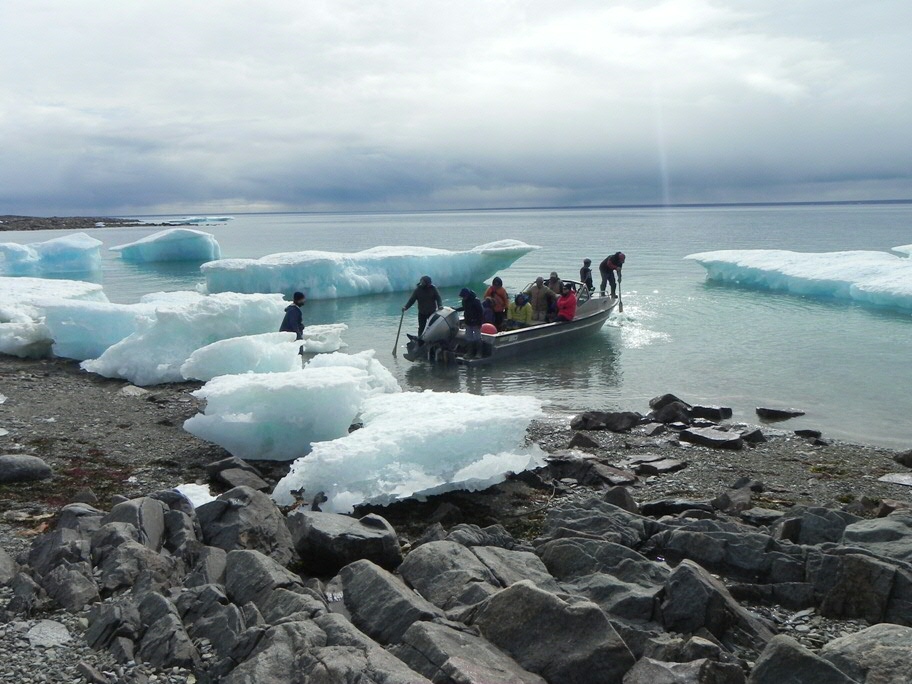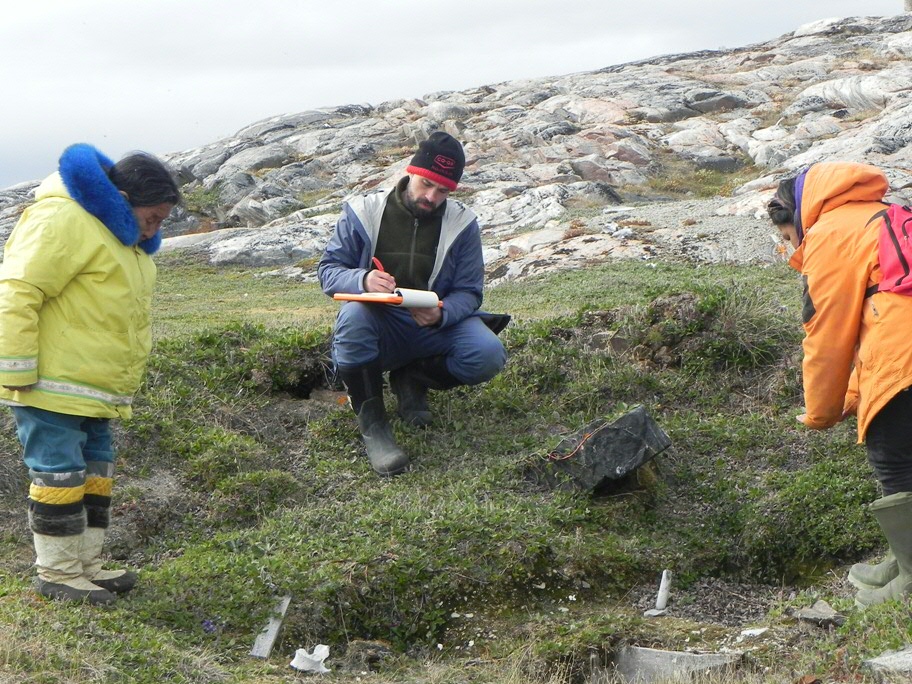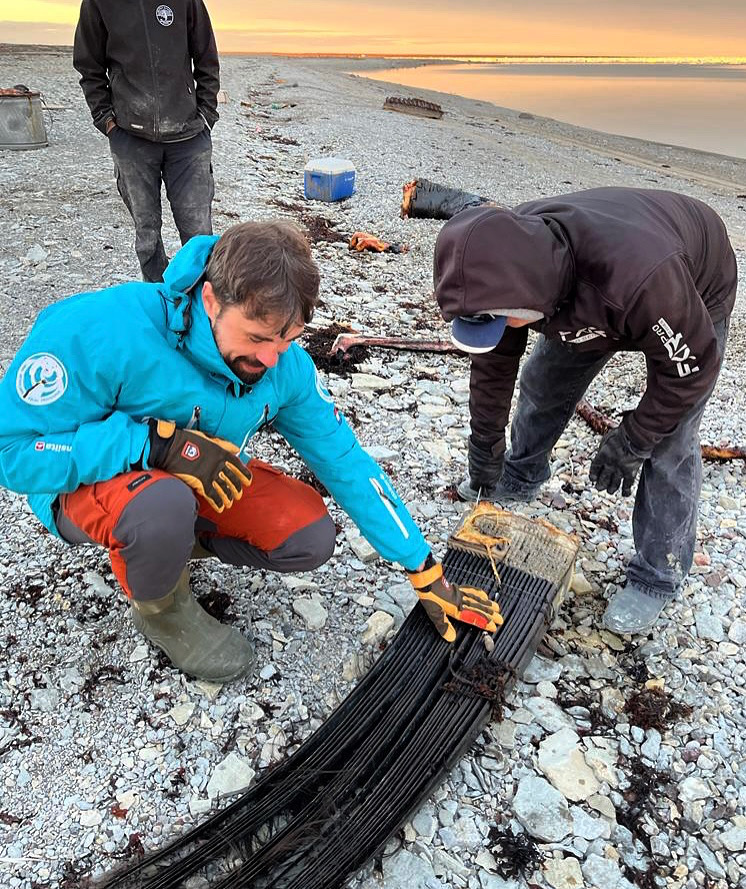Traditional knowledge and Western science meet at the North Pole
Dr Sean Desjardins , assistant professor of Anthropological Archaeology at the Faculty of Arts, is in the Canadian Arctic researching the Inuit past in close collaboration with the Inuit community. He charts their traditional knowledge, integrating it with Western science and technology so that the Inuit, in addition to their own know-how, have additional tools to advocate for their interests to governments and other policymakers. ‘Any study of the Inuit past must prioritize their interests.’
Tekst: Theone Joostensz
With summer temperature highs of ten degrees, the mercury dropping to minus thirty in winter and an icy polar wind, you will understand that camping in Arctic Canada is not everyone’s idea of fun. For Sean Desjardins, however, it is heaven on earth. Since 2010 he has travelled annually to Foxe Basin, an area in Nunavut in northern Canada, home to the Inuit community with whom he has worked for years. He researches their traditions and customs and how they have evolved over the centuries.
‘Foxe Basin is a fascinating region, both biologically and historically,’ says Desjardins. ‘Warm water patches provide partly open water, even in winter. The area has a great diversity of animals, such as different species of birds and marine mammals, including the largest population of walruses in Canada, which are abundant all year round. The first people who arrived here had a strong hunting tradition, and even today, walruses and seals are still hunted.’
Archaeological finds indicate that as early as the fourteenth century, people lived in Foxe Basin who depended on hunting for their livelihood: ‘We have excavated animal bones from old rubbish dumps, sometimes with remnants of meat on them, that are four or five hundred years old. This is another reason why this region is so interesting: everything is extremely well preserved. It’s fantastic for DNA research and carbon dating, a method that allows you to determine the age of certain archaeological finds, such as bones. We have this done by the CIO, the Centre for Isotope Research at the University of Groningen, one of the best and oldest centres for this type of research.’

Place with many houses
The Inuit community in which Desjardins works is called the Igloolik - indeed derived from the word igloo - which literally means ‘place of many houses’. The Inuit were nomads for centuries but were forced to settle in villages in the 1950s by the Canadian government. Their children were separated from them, not always with the consent of their parents, and placed in boarding schools in order to assimilate them into Canadian society. This collective trauma has left its mark on the Inuit community and they are often appropriately wary of Westerners and their motives. It took a while for Desjardins to gain the trust of the Iglulingmiut, the people of Igloolik.
He is now a welcome guest and also speaks some Inuktitut, the language of the Inuit in Canada. ‘I have worked with older Inuit who were born and raised in Avvaija, one of the last Inuit camps,’ says Desjardins. ’Many speak only Inuktitut, no English or French, and possess valuable knowledge, for example, about hunting, which has been passed down orally from generation to generation for centuries. Not so long ago, these older Inuit led a nomadic existence, moving around the country with the seasons and living in tents made of skins. Now they live in houses with cable TV, and their grandchildren are on TikTok and Instagram. I know of few peoples who have experienced such dramatic social change in such a short time.’

Indigenous and Western knowledge
Desjardins’ research aims to understand the Igloolik’s past, to learn how people lived in this area, particularly how they hunted. To do this, he integrates the Iglulingmiut’s traditional knowledge with Western research methods to answer questions that the community considers important, such as: how did they hunt in the past, were there the same number of animals in the past as now, how have the traditions of hunting developed, how can the problems faced by Inuit hunters today be solved?
‘Walrus hunting is regulated based on estimates by biologists who conduct scientific research on animal numbers. However, their estimates are almost always too low, and that affects how many animals the Inuit hunters are allowed to shoot.’ Desjardins emphasizes that the biologists are not the enemy: ‘They want the best for the animals and for the people but they use a Western scientific method that is not always consistent with the traditional knowledge of the Inuit. To give an example: in East Greenland, the narwhal, an arctic-toothed whale, is heavily hunted. Biologists in Nuuk, the capital of Greenland, say the narwhal is threatened with extinction by the hunters. While they say: ‘We have been doing this for thousands of years, we know that the population is healthy enough because we hunt sustainably.’
Desjardins wants to inform the non-indigenous population about the hunting techniques of the Inuit and how they have evolved over the centuries. For instance, spears and dog sledges have long since been replaced by guns and motorboats, but it is a misunderstanding to think that many more animals are being shot as a result than in the past: ’People have long since ceased to depend on animals for their food and clothing, so there are far fewer hunters than there used to be. We would like to investigate further how many animals are actually hunted.’

Better understanding
Desjardins thinks that in an ideal world, the governments that set the rules and restrictions for hunting would base them on the knowledge of the indigenous population. ‘It is very difficult to combine traditional and Western knowledge because they are based on very different methods. They are both valuable. I see my work as facilitating; I use the methods I know to investigate the past to answer questions that are important to the Iglulingmiut. They already know a lot about their ancestors. We show what archaeology can do and how it can complement their traditional knowledge and experience. For example, one of my PhD students examines artefacts we have found in Foxe Basin at a microscopic level to learn how they were made and what they were used for. Another PhD student is studying ancient walrus DNA from this region to see how hunting and environmental factors have affected the walrus population. Any study of the Inuit’s past must prioritize their interests.’
Desjardins wants to gain a better understanding of how hunting in the past and the present are connected: ‘I want to bring all that knowledge together and develop a toolkit with the Igloolik community so that they are better equipped to negotiate with governments and policymakers about hunting.’
| Last modified: | 02 May 2024 1.53 p.m. |
More news
-
12 March 2025
Breaking news: local journalism is alive
Local journalism is alive, still plays an important role in our lives and definitely has a future. In fact, local journalism can play a more crucial role than ever in creating our sense of community. But for that to happen, journalists will have to...
-
11 March 2025
Student challenge: Starting Stories
The Challenge Starting Stories dares you to think about the beginning of recent novels for ten days.
-
11 March 2025
New: Sketch Engine, tool for language research
Sketch Engine is a tool for language research, which can also be used for text analysis or text mining.
